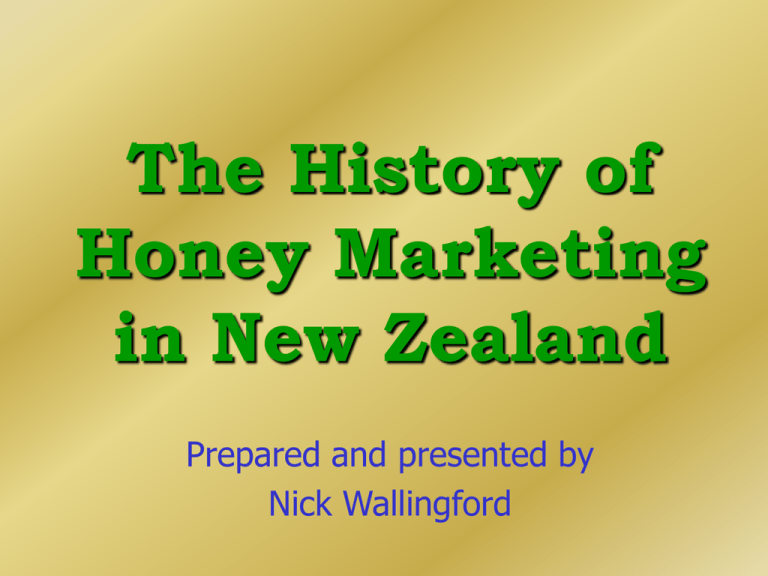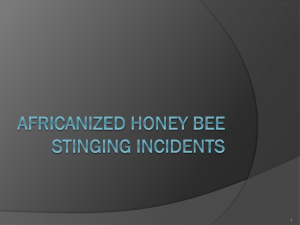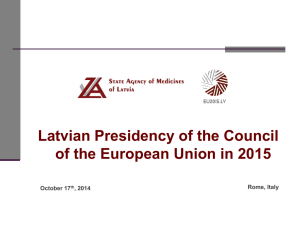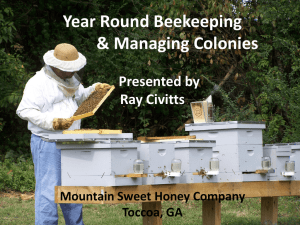marketing - Beekeeping.co.nz
advertisement

The History of Honey Marketing in New Zealand Prepared and presented by Nick Wallingford What can we learn from history? Maybe not a lot, but who knows? … Recognise some of the trends, the repeating charteristics Appreciate the features that seem to ‘act’ upon the industry Don’t expect much - but maybe you’ll at least enjoy yourselves! ‘Better Beekeeping, Better Marketing’ A ‘mission statement’ for the National Beekeepers’ Association for many, many years Close relationship between the industry association and marketing efforts Recognition that producing is not enough the return for the producer has other influences... Overview... Strong-willed individuals, high/low crops, attempts to control internal/external sales of honey Early years, Honey Producers Co-operative (HPA), The NZ Honey Co Ltd, NZ Honey Control Board, Internal Marketing Division, Honey Marketing Authority History of marketing, but also of the NBA The early years... Honey sold into England in 1880s, but irregularity of supply and speculation NZ’s best clover honeys were the equal in quality Hopkins and Mulvaney sent 5 tons, but it granulated - adulterated with flour! While honey in England was retailed at 1/6 to 2/- per pound in glass, NZ producers were only getting 3d or 4d per pound Instruction and Regulation Isaac Hopkins, apiarist to the Department of Agriculture, established apiary at Ruakura Farm of Instruction First honey house in 1906 costing £45 First Apiaries Act in 1906 Prior to the NBA Not just a bunch of hobbyists, even then crop of 32 tons in 1907 Slowing working toward the elimination of box hives Fletcher Branthwaite (Tai Tapu), took 10 tons to England in 1907 - later had remainder sent back to NZ The marketplace... Most Auckland honey from Great Barrier Island, 2 pound tins, varying from pohutukawa to manuka Well packed lines from the few commercial beekeepers in the Waikato - medium amber, strongly flavoured with pennyroyal and manuka Southern North Island had J Walworth (Palmerston North) and William Lenz (Masterston) each with crops to 30 tons Early apiary inspectors WB Bray, Robert Gibb, Isaac Hopkins the original three, appointed in 1907 Those famous bicycles – really motorised? ... Big crops, substantial exporting... 1909/1910 Canterbury had record season, with average crop 200 pounds per hive Price cutting saw returns drop to 3d per pound and lower… Total exports for 1912/1913 586 hundredweight (value £1,182) - by end of 1913 nine month sales were 1,690 hundredweight (value £3,293) The moves toward organisation... Mr Hull, President of Canterbury Assn, suggested conference in Wellington in 1913 - proposing name of Federated Beekeepers’ Association of NZ 1913 Canterbury formed a co-operative association to export honey Department of Agriculture drew up voluntary grading regulations (based only on colour) Co-operation started in Taranaki... In 1913 Mr W Lenz decided to sell his Taranaki holdings Small co-operative bought bees and sold to members in lots, and acted as marketing operation HW Gilling, HR Penny, AR Bates among the 8 members Based around packing operation of HW Gilling in Hawera No initial capital - deductions from payments for honey supplied The National Beekeepers’ Association Value of honey production £50,000 when Hon R Heaton Rhodes opened the 1914 conference in Wellington James Allan (Wyndham) elected President Membership of 256, expecting to double in the coming year Early NBA Conference Major A E M Norton... Managing director of the Bristol and Dominion Producers’ Association Ltd Formerly Trade Commissioner in England for South Australia Promoted branding by country and regularity of supply for continued sales Offered to contract for 100 tons minimum, 500 tons maximum for three years, at 4d FOB minimum, 5d possible... The beginning of organised exports NZ Co-op Honey Producers’ Association took up the contract Increased authorised capital, accepted other shareholders Grading regulations became compulsory, leading to increased exports, ‘respectability’ of the product, increased local prices Failure to supply... By end of 1916 the HPA had several hundred shareholders Exports fell 30 tons short of the required 100 tons Major Norton and the B & D expressed concern, but didn’t try to recover damages B & D substituted cardboard containers for glass in innovative packaging move The honey to England Light and dark honeys accepted by B & D for sale into England Lighter honeys sold in southern cities, darker sold in the north Darker sold as ‘New Zealand heather honey’ until Agricultural Dept pointed out there was no heather! “What harm could it do anyone to call it that” the Editor argued... Calls for co-operation Late 1916 WB Bray called for co-operation If the small crop had all been exported, local prices would have soared Windfall for the non-HPA members Urged HPA members to turn high local offers over to the HPA rather than filling them individually “We want to ride in a motor car too some day” High prices, but problems with the B & D contract Sugar under control in England, honey prices soared HPA paid out 8 1/3 pence per pound late in 1917! Crop estimated at 1,250 tons, with HPA advancing 4 3/4 per pound on the two grades By early 1917 some problems with shipping space to England The end of the War... In 1917 stocks on hand were shipped to England Cheaper Australian and Californian honey, along with cheap corn syrup, had created consumer resistance Reduced buying power for English consumers Some NZ honey in store had fermentation problems... Problems for the Bristol and Dominion Producers’ Assn B & D had considerable stocks of HPA honey HPA had two seasons’ honey in stock, overseas market with low consumption depressed by poor quality honey still held by retailers High prices for 1918 crop locally and for export… Conference 1918 (Wellington) Shareholders vs their Association Many HPA shareholders selling for shortterm profit outside of the organisation HPA paying 9d for honey in June, but only getting 5 1/2d advanced, with the rest to come when the honey was shipped HPA had 300 tons accumulated in shipping stores By 1919 HPA calling up subscribed but unpaid capital The slide in prices... By 1919 price in England down to £100 per ton - half of what it was the previous year Returns to beekeepers revised down from £150 to only £75 per ton over a period of two months… HPA advertised “Civil War in NZ” and “Outbreak of Hostilities - a Warning to the NZ Beekeeper” Troubles for the B & D... 1921 the Bristol and Dominion Producers’ Assn Ltd went into voluntary liquidation Considerable volumes of honey held both in NZ and England 1920 crop marketed mostly to NZ, the US and Canada (because of bad crops there) Americans and Canadians enforced a 3 cents per pound import duty! Re-establishing an export presence... AJ Mills and Co suggested as agent to handle NZ honey in England Unsettled claims and counterclaims from B & D’s liquidation ultimately cost £10,000 Editor described beekeeper who did not support the HPA or competed with it as “a drone, a cheat, a traitor or a deadbeat!” The ‘new’ Ruakura honey house, 1923 The ‘bad years’... By 1923 honey was down to 4 1/2d per pound Prices for Californian honey in London continued to fall with the failure of their co-operative association HPA members told to quit as much locally as possible to try to let Mills and Co catch up on the backlog of honey Call for board of NBA, HPA and Govt to supervise exports to England Good crops, even worse years... 1927 had local market fully stocked, price cutting widespread 1927/1928 crop one of largest ever, with 1,029 tons exported Local market prices low, beekeepers just trying to get quit of it NBA wanting to stabilise the local market before it was completely ruined The end of the HPA... HPA only being used to dispose of honey, even by previously loyal shareholders AJ Mills and Co worrying over the outlay to pay advances, having troubles with sales Government agreed to £9,000 assistance for advertising in England Schemes to control local marketing considered essential ‘Better Beekeeping, Better Marketing’ PA Hillary began to publish “The Alighting Board” WB Bray began publishing “The New Zealand Honey Producer” July 1929 The ‘Contract Scheme’ Attempt to get 75% of the 1,200 HPA shareholders to either sell through the HPA or at uniform price, uniform package Hope that this could stabilise the local market, with 1/2 penny per pound of honey on advertising to increase consumption Payout for 1929 only half of the previous season... And a bad season... 1929/1930 honey season the worst for 15 years, probably only one third of the previous season’s record big crop - two record seasons, one disastrous season and a world depression… C and E Morton take over as agents for the HPA Christchurch Conference 1931 The start of the 1930s, the end of the HPA... PA Hillary elected President of the NBA in 1931 Proposal to extend the powers of the Honey Control Board to local market Proposal to create ‘equalisation fund’ to encourage exports In July 1932, HPA finally placed itself into voluntary liquidation Who’s the boy? And out of the ashes... New Zealand Honey, Ltd picked up where the HPA left off, at a time when honey had dropped to as low as 2 1/2d per pound Shareholders could be compelled to supply 50% of their crop to the company NZ Honey came into being after failure of the honey crop and the failure of competitive open marketing 1932 Conference And that Seals Levy... Wallace Nelson of Otorohanga first proposed the use of a ‘seal’ to be fixed to containers of honey sold as part of a marketing association ‘Sealed honey’ would assure the public of superior quality and stability to the marketing organisation Trying to fix the bad spots... NZ Honey required definite proportions of crops Shareholders had to agree not to sell at less than the Association’s listed prices Members fixed seal to indicate 1/2d paid levy on honey sold directly While NZ Honey was selling the honey, it was still under the control of the Honey Control Board Imperial Bee brand... Branding of honey as ‘NZ’ had resulted in consumer acceptance/confidence in the Imperial Bee label Owned by the HPA up to time of liquidation Government advanced money to NZ Honey to secure the goodwill and trademark Reasonable stability... 1930s had local market price cutting, but a slow increase in export returns Many producers saddled with paying back the over advances from the HPA Payout up to 4 1/2d per pound Creamed honey... Dr EJ Dyce had patent right to the processing of honey to create ‘creamed honey’ Rights were revoked in 1935 after the NZ Honey Control Board took an action NZ Honey Control Board got two guineas for costs... Another knock... C and E Morton (HPA’s agents in England) claimed £17,000 for overpayment of advances Governement agree to loan the industry £10,000 to reduce the debt The issue of ‘control’... Commission of Agriculture held enquiry, concluding that there should be a single authority to supervise the whole of marketing (local and export), and a ‘pooling’ with payments by grade 1936/1937 again one of those ‘worst crop years’… Honey Control Board and NZ Honey Co wanted to maintain existing markets... The Australian honey... Importers claimed the honey was never to be sold in New Zealand or blended with Imperial Bee pack Intended only to supply as ‘manufacturing grade’ NZ Honey Ltd ceased trading after 4 1/2 years, having increased returns from 4 1/2d per pound to 6d The Internal Marketing Division Labour Government... In 1938 the IMD took over NZ Honey Ltd’s business and plant at valuation NZ Honey Ltd wound up, paying back all shares and capital and 6d per pound pro rata on the last year’s honey All producers selling outside of the IMD to affix a stamp for 1/2d per pound... The basic problem... By the late 1930s, beekeepers knew that high prices in a season of shortage were of no real use when prices fell to unprofitable level when crop was above average IMD attempted to stabilise the returns to beekeepers War brought more problems... The new packing plant... IMD built a new packing depot in Auckland One half of total crop produced in the Auckland province and two thirds of total crop came from the North Island New plant required high proportion, consistent supplies and support Aiming for all export and storage for export, as well as the 700 to 800 tons for NZ trade And a bad season... Short season in 1937/1938, good one in 1938/1939, but 1939/1940 was one of the worst on record Hardly any ‘carry over’ honey Pressure to obtain supplies for overseas commitments Speculators operating... Support for the IMD... Producer/packers urged by the IMD to reconsider packing operations “6 1/4d per pound plus payout should make packers reconsider” Opposition primarily from South Island Concept of ‘zoning of marketing areas’ giving IMD sole selling rights seen as necessity by some And another bad year! 1941/42 was worst ‘since honey production acquired the status of an industry’ GS Kirker remarked “By marketing their honey independently of the Division while good times continue beekeepers might reap a harvest, but they will surely need a marketing organisation at the end of the war - and probably sooner if there is a succession of bumper crops.” Freezing of prices and costs... 1943 saw price and cost controls introduced Internal prices to be divorced from export parity, with excess to be paid into pool accounts 7d per pound pro rata was considered too low a base price The Marketing Scheme Compulsory supply of 70% of crop for all beekeepers with 20 hives or more Remaining 30% could be disposed of by the beekeeper Existing producer/packer facilities to be utilised allowing for all the year round work for those businesses Canterbury flatly refused - the ‘Canterbury viewpoint’... Controlled marketing... IMD claimed that from 1940 until the late 1930s the price of honey had not depended on the size of the crop or individual ability to ‘master the market’ It depended entirely on some organisation to take the surplus market off the local market and obtain a good price on a market built up overseas, often after considerable effort The failure to supply... The 70% acquisition expected 1,400 tons Only 760 tons supplied from beekeepers… IMD warned that the current high prices and demand were solely due to the war, and pointed to similar situation in England in the early 1920s 1944 brought same 70% ‘commandeering’ with required reporting, maximum customer size of 5 pound tin The end of the war 1944 marketing plan to commandeer only 30 or 35 pounds per hive, approximately 50% of the crop Seals levy fund now stood at £17,000, with £50,000 total reserves IMD still not being supplied with enough for war requirements, supply of honey to cities Voluntary supply War time regulations called for 70% supply, but never more than 20% of total crop ever used for war priorities Est. crop of 3,000, suggest supply 1,000 to IMD; half of remainder sold direct to consumer, half to trade (with seals levy) This £5,000 to supplement bulk supply, allowing payout of 8d per pound IMD was not being supported - 85 tons in 1946! Another association... The appointed Honey Control Board (W Nelson) a point of contention Honey Suppliers’ Assn formed to represent those who supply the IMD which proposed increased payout coming from seals revenue Use of seals ‘tax’ change from advertising to equalisation ‘Unique marketing situation…’ Low crop, high consumer demand Front door selling in favoured areas of entire crop in bulk direct to consumer Cancellation of sugar subsidy for manufacturers Continued rationing of sugar to public Control, responsibility for marketing Honey Control Board was ‘advisory only’ to the government; IMD decisions were seen to be an imposition on the industry By 1947, call for a new ‘set up’ to exercise measure of control, responsibility for marketing decisions Early 1948 saw Honey Marketing Committee (Field, Holt, Nelson) formed to prepare for election of a producers’ board Policy for 1949/1950 Pool account Standard pack within NZ No obstruction to private producer-packers Ensure use of honey seals Maintain and develop export market (aim at 500 tons of Imperial Bee standard) Close liaison with Marketing Committee, IMD and producers Another complicating factor... ‘Stabilisation’ following the war kept the price of honey fixed Price Tribunal was loathe to increase the price of honey in NZ, protecting the consumer When prices were increased, it occurred after tremendous effort and long delays Alternative viewpoints... WB Bray: “Enable the producer to control the marketing of his crop with a view to freedom in association with other producers” Wallace Nelson: “Need for confidence in marketing organisation to ensure adequate supplies of honey, with full administrative responsibility over the IMD, giving control to the producers” 1950: What the industry wanted... Organised marketing through central packing depot or depots Contracts of supply from producers Simpler method of collecting levy Franchise for suppliers and contributors to the Seals Levy on equal basis Seals reserves and revenue be administered by the Honey Marketing Committee Executive of 1951 The Seals Levy... Set at 1/2d per pound back in the 1930s By the early 1950s it had not changed, and was not providing the revenue required to supplement payouts Still many claims of avoidance Changes requested in 1952 Seals Levy to increase to 1 penny per pound, purchasers (as well as suppliers) should be eligible for nomination to the Honey Marketing Committee The Honey Marketing Committee opposed the nomination of seals levy purchasers Minister Holyoake appointed a purchaser (EA Field) as the Government representative! Primary Products Marketing Act, 1953 Hand over to producers the marketing of primary products Internal Marketing Division is abolished Benefit of existing government finance arrangements To pay due regard to general Government trade policy Government representative to consider interests of consumer Attempt at subsidy... 6,000 ton average crop, 4,500 consumed in NZ 1,500 tons required to export Called for government subsidy on seals levy to acknowledge pollination value of the industry! KJ Holyoake, Minister of Agriculture: “Nice try…” A new marketing authority A resounding ‘yes’ - 245 producers (80,000 hives) yes, 15 (with 5,000 hives) no… Six member board: 4 elected producers, 1 appointed NBA representative, 1 Government representative First members: R Davidson, EA Field, WT Herron, WW Nelson (with Executive Director Williams the NBA representative) Seals Levy retained There was little disagreement that a form of ‘internal contribution’ to the marketing body was required Seals Levy retained Kimpton Brothers... Appointed as agents to the HMA in 1954 Sold over 2,000 tons in first year at a steadily increasing price for all grades Returns close to local parity Colonel Kimpton said it was honey grading regulations coupled with export control regulations that made it possible Southland beekeepers Price Control After 16 years by 1957 Price Control (ceiling price) had lost favour with beekeepers Stability created by the HMA should be able to set fair price Export bulk prices beginning to exceed local packed prices… Same issue that announced decontrol announced return to Price Controls! Executive 1957 Veteran beekeepers, 1957 WB Bray (Leeston), AR Bates (Matamata), C Horner (Te Aroha), A Pearson (Hamilton), TH Pearson (Auckland), HC Wedde (Raurimu), H Geddes (Rotorua), E Sage (Ohaupo) The HMA debt The HMA in the late 1950s had a high level of debt, and consequent low confidence from beekeepers £100,000 debt after taking over from the IMD New building in Parnell (after old IMD building had rent increases) Request for government grant in lieu of seals levy evasion The HMA’s trading position Overseas realisations were not as high as the local returns Essential that several thousand tons were exported to maintain local market stability 75% of honey supplied to HMA was being exported Lack of Seals Levy plus low export returns meant low payout meant decreased supply Government investigation ‘Form a committee’ Submissions from NBA, branches, HMA and others Ultimately decided to move all the debt over to Reserve Bank overdraft facilities Same facility that Apple and Pear Board and Dairy Commission already had… Suggest increase in Seals Levy to 1 1/2d, extend to all honey in retail containers Change in representation NBA had member on HMA as of right; that was lost In 1960 Wallace Nelson lost his position on the HMA after 28 years without defeat (back to Honey Control Board days). WB Bray defeated, too (health reasons) Jack Fraser and Jim Barber, both NBA Executive, became producer representatives; George Gumbrell chairman Compulsory acquisition 1961/1962 was below average season, but 1962/1963 was a good one Price cutting on top quality honeys Call for compulsory supply or several restricted local sales-outlets for producers Darker honeys, especially, receiving low returns Light honey producers keen to sell overseas on own account The Kimton Agreement No exports to UK or bulk exports to any other country Small consignments in retail containers considered alright Light honey producers feeling that the pool system was not giving them fair return Percy Berry elected to HMA with promise to terminate the contract Acrimony and division... Public slanging through the industry journal on merits of sole agent 1964 election of Dudley Lorimer and Jack Fraser indicated support for the Kimpton Agreement and HMA policy ‘The alternatives have been categorically rejected and the disruptive elements in the industry have been summarily dealt with’ G Gumbrell, retiring Chairman P Berry defeated in 1966 And the small crops again... Two below average seasons, followed by 1966/1967 which was a disaster Conscious decision by HMA that the future was in the export of bulk honey Distance from markets, competition in retail sales, difficult markets seen as barriers to change With small crops, though, the HMA wanted to maintain the goodwill of domestic brands ‘Buyer of last resort’... Jack Fraser in 1969 described history of the Seals Levy HMA bound to accept all honey offered to it Processing, blending these honeys to raise sales value would be a direct charge on the pool Seals Levy acts as an ‘industry fund’ Executive (visit to Wallaceville), 1969 The 1971 proposal President Bruce Forsyth proposed no Seals Levy but a flat 2 cents per pound producers’ levy Import distinction was producer to pay, not packer Changes to Kimpton Agreement Agreement with Kimpton’s changed from 12 months notice to 6 Changed formula for calculating commission Sole agent for bulk honey, but packed lines can be sold in their territory And another committee... Committee of Government Caucus on an Inquiry into the NZ Honey Industry, 1972 Recommended HMA remain, but not ‘compete vigorously’ Allow for exports without approval of the HMA, levy proposed on the sale (not production) of honey But 1972 conference voted against private exports… High overseas prices... By 1973, honey prices had increased dramatically HMA payout fixed by Government at 20 cents when HMA wanted to pay out higher Government wouldn’t let HMA increase domestic honey price, either Executive, 1973 Changes to the levy HMA wanted extension of current scheme, paid by packers on containers, with more enforcement powers (the ‘Ecroyd scheme’) NBA wanted extension to full producer levy, based on declarations (the ‘NBA scheme’) But by 1974, NBA membership moved to favour a ‘hive levy’... Rising costs, pegged prices... HMA unable to include increases in production costs as justification for increase in wholesale price of honey Government involvement in local market pricing as well as (recently) price smoothing of producer incomes Hive Levy Act provided for 5 cents per hive stabilisation levy HMA and private exports Retail packs, 10 tonnes or less, subject to HMA approval Exports could not be allowed to jeopardise the ability of the HMA to maintain a stable domestic market and export by 1976 need for representation of all producers in HMA decisions (P Berry elected previously) Remits in 1976, 1977 and 1978 calling for private bulk exports... The HMA composition Two in favour of private exports, two more desirous of HMA control, and the Government representative… Late 1978, the deadlock was broken, with majority in favour of private exports HMA at 1979 conference... Financial position, inflation worrying Traditionally buying all honey offered, sole right to export bulk honey - act as buffer against high or low production years Funding system borne by the industry as a whole and/or complete export control Conference decided HMA could restrict honey to accept... Stabilisation scheme With no Seals Levy, HMA operated a ‘base price’ and ‘trigger price’ system Any realisation in access of the trigger price would go to reserves Base price was used to determine ‘cost price’ of honey for local market, so packers were selling for less than they could in bulk to the HMA! New policy formulation Admin of export control to go from HMA SI operation could be only commercial HMA involvement Control over exports still desired Centre for export control to be placed in hands of ‘alternative body’ Export control office should set minimum export price The Dellow report, the Kay arbitration Outlined financial, political, administrative and marketing structures necessary for success of proposed Honey Marketing Coop Decision on who to benefit/how to handle the HMA reserves Decision to loan funds to Co-op challenged by injunction Arbitration led to a trust, the loan, and the ultimate end of the HMA





